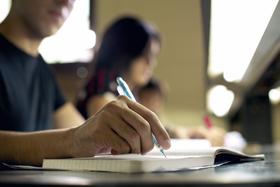Top Rankings
Wayne Township Public School District ranks among the top 20% of public school district in New Jersey for:
Category
Attribute
Graduation Rate
Highest graduation rate (Top 10%)
Community Size
Largest student body (number of students) (Top 1%)
For the 2025-26 school year, there are 2 public high schools serving 2,416 students in Wayne Township Public School District. This district's average high testing ranking is 8/10, which is in the top 30% of public high schools in New Jersey.
Public High Schools in Wayne Township Public School District have an average math proficiency score of 45% (versus the New Jersey public high school average of 29%), and reading proficiency score of 60% (versus the 47% statewide average).
Public High School in Wayne Township Public School District have a Graduation Rate of 96%, which is more than the New Jersey average of 91%.
The school with highest graduation rate is Wayne Valley High School, with 97% graduation rate. Read more about public school graduation rate statistics in New Jersey or national school graduation rate statistics.
Minority enrollment is 31% of the student body (majority Hispanic), which is less than the New Jersey public high school average of 63% (majority Hispanic).
Overview
This School District
This State (NJ)
# Schools
15 Schools
548 Schools
# Students
7,653 Students
467,298 Students
# Teachers
691 Teachers
36,806 Teachers
Student-Teacher Ratio
11:1
11:1
Student By Grade
District Rank
Wayne Township Public School District, which is ranked within the top 30% of all 645 school districts in New Jersey (based off of combined math and reading proficiency testing data) for the 2022-2023 school year.
The school district's graduation rate of 96% has increased from 95% over five school years.
Overall District Rank
#159 out of 648 school districts
(Top 30%)
(Top 30%)
Math Test Scores (% Proficient)
55%
38%
Reading/Language Arts Test Scores (% Proficient)
64%
49%
Science Test Scores (% Proficient)
34%
23%
Graduation Rate
96%
85%
Students by Ethnicity:
Diversity Score
0.51
0.72
% American Indian
n/a
n/a
% Asian
10%
10%
% Hispanic
17%
34%
% Black
2%
17%
% White
68%
37%
% Hawaiian
n/a
n/a
% Two or more races
3%
2%
All Ethnic Groups
District Revenue and Spending
The revenue/student of $27,104 is higher than the state median of $26,940. The school district revenue/student has stayed relatively flat over four school years.
The school district's spending/student of $26,124 is higher than the state median of $25,837. The school district spending/student has stayed relatively flat over four school years.
Total Revenue
$207 MM
$36,642 MM
Spending
$200 MM
$35,142 MM
Revenue / Student
$27,104
$26,940
Spending / Student
$26,124
$25,837
Best Wayne Township Public School District Public High Schools (2025-26)
School
(Math and Reading Proficiency)
(Math and Reading Proficiency)
Location
Quick Facts
Rank: #11.
Wayne Hills High School
(Math: 51% | Reading: 61%)
Rank:
Rank:
7/
Top 50%10
272 Berdan Avenue
Wayne, NJ 07470
(973) 317-2000
Wayne, NJ 07470
(973) 317-2000
Gr: 9-12 | 1,181 student Student-teacher ratio: 10:1 Minority enrollment: 30%
Rank: #22.
Wayne Valley High School
(Math: 39% | Reading: 59%)
Rank:
Rank:
6/
Top 50%10
551 Valley Road
Wayne, NJ 07470
(973) 317-2200
Wayne, NJ 07470
(973) 317-2200
Gr: 9-12 | 1,235 student Student-teacher ratio: 10:1 Minority enrollment: 31%
Recent Articles

Charter Schools vs Public Schools 2025: Key Differences & Trends
Explore updated 2025 insights comparing charter schools vs public schools, enrollment, academic outcomes, funding, and real-world examples for families and educators.

Are Public Schools Ready for the 21st Century? 2025 Update
Explore 2025 insights on whether public schools are ready for the 21st century, covering performance, technology, equity, funding, and future-ready learning.

Public School Open House & Enrollment Season Guide
A parent-focused guide to the public school open house and enrollment season, with expert questions, timelines, and decision tips.





